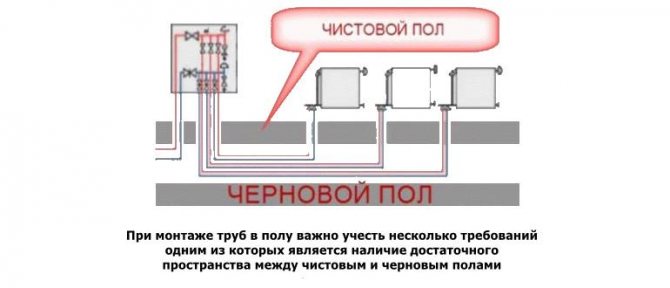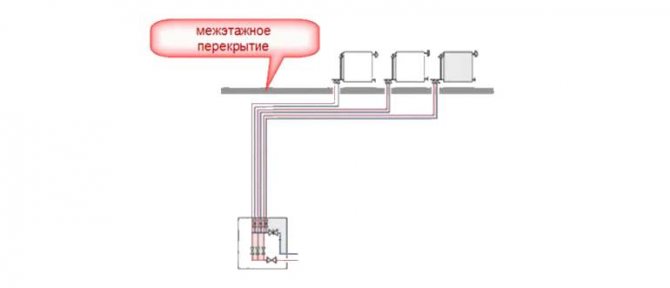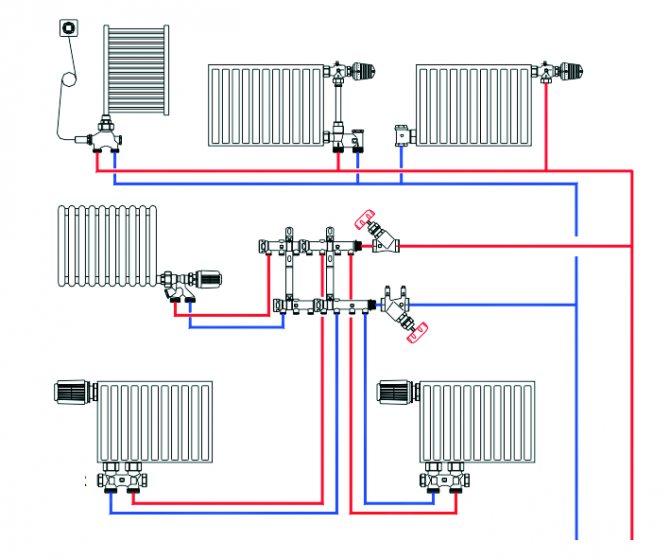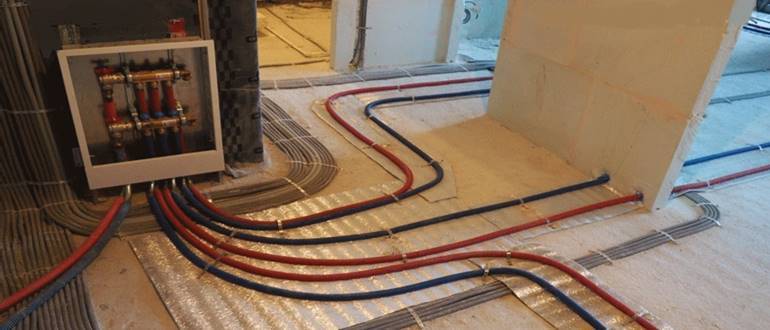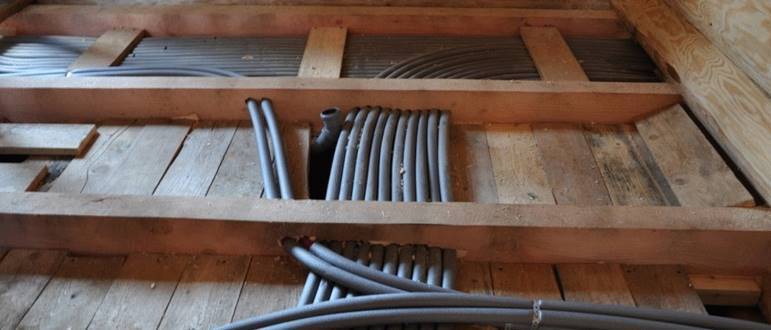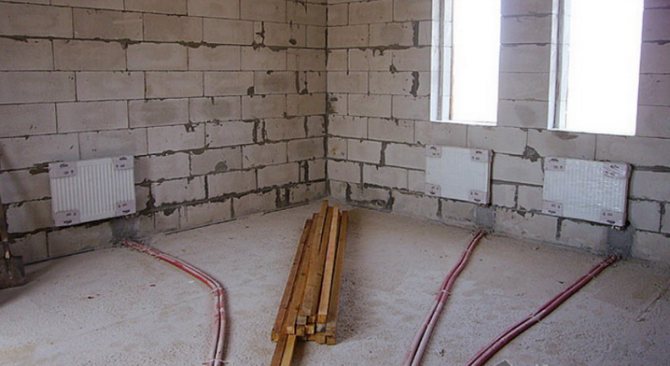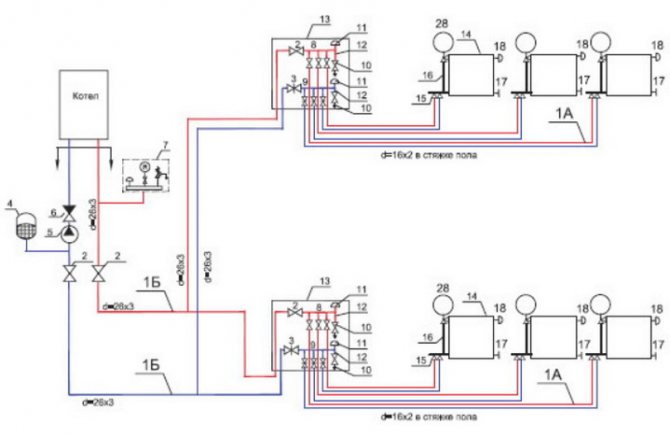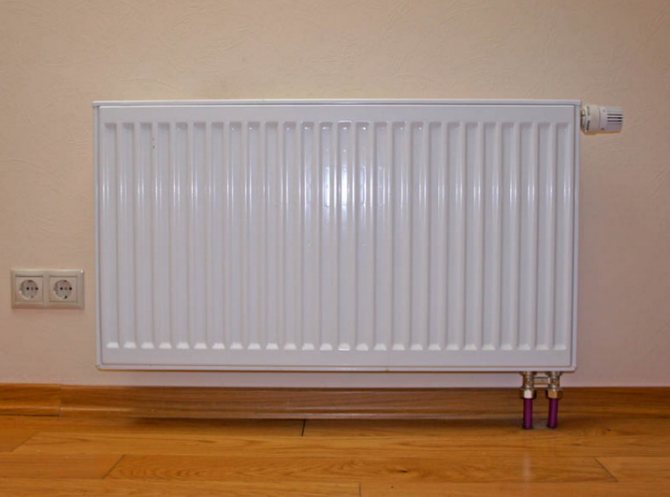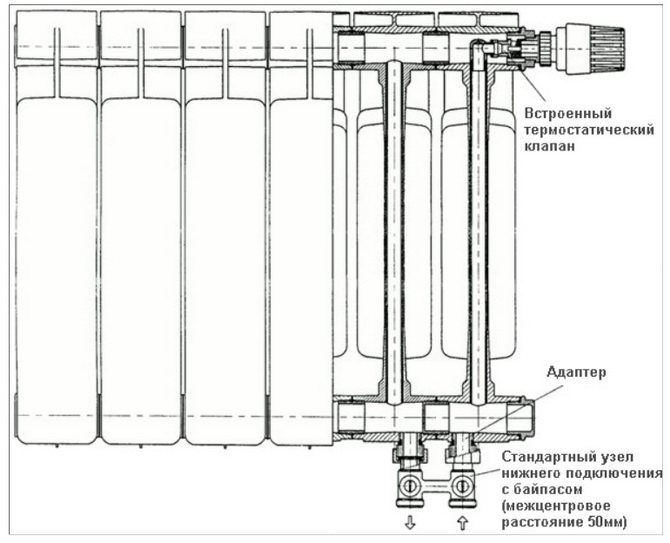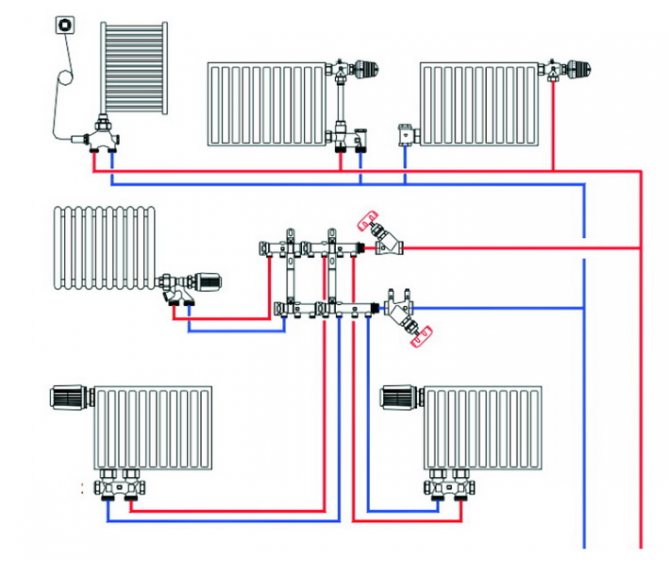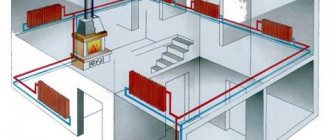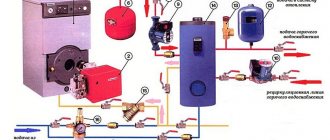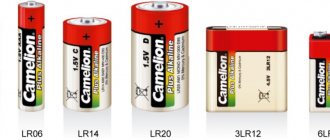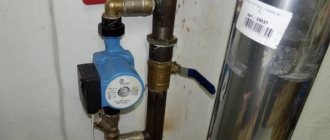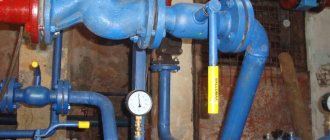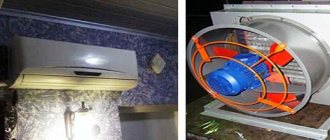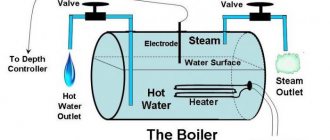All types of heating systems have a common set of structural elements. This is a boiler that serves as a source of heat generation; a circuit consisting of pipes and heating devices. The differences between the different types are in different pipe arrangements.
One of the most famous wiring is the radiant heating system.
The main difference between the radiant heating system and other systems is that here, with the help of a collector unit, separate pipes for supplying and removing liquid are drawn to each battery.
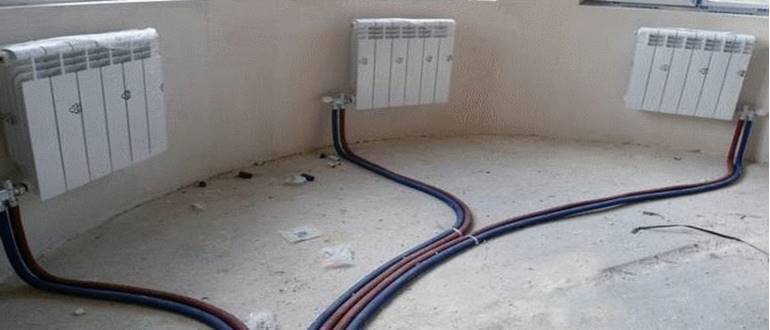
Radiation heating system of a private house
Thanks to this method, you do not have to turn off the entire system in the event of a breakdown of individual elements. Also, there will be no need to install bypasses, which will greatly simplify installation and reduce the total cost.
Considering the advantages of this system, it is worth noting:
1. Easy installation thanks to the use of pipes of the same diameter and a small number of fittings. 2. The pipeline "wound" into the walls and floor does not spoil the interior. 3. Increased functionality, with the device additional. elements (for example: thermoregulation sensors, air vents, etc.) 4. Possibility of setting different defined temperatures in separate rooms. 5. Repair and replacement of radiators separately, without shutting down the entire system. 6. Uniformity of heating.
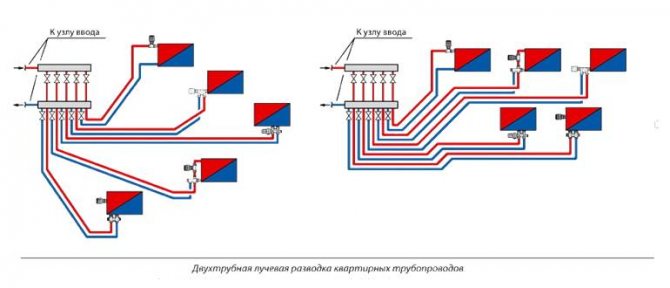
Diagram of the radiant heating system of the apartment
Elements of the collector heating circuit
Radiation heating of a private house is a structure consisting of several main elements:
- Heating boiler
... This device is the starting point, since from it the hot coolant is directed to pipelines and radiators. The power of the heating unit must correspond to the heat transfer of the heating equipment. There is the following nuance here: the radial layout of the heating system, unlike other options for laying the pipeline, has a greater degree of heat loss, which must certainly be taken into account when calculating the parameters of the equipment. - Circulation pump
... According to the peculiarity of its device, the radial heating distribution is of a closed type and for its functioning requires forced circulation of the heat carrier fluid. For this purpose, a special pump is installed that creates a certain pressure and pumping liquid. As a result, the required temperature regime is provided, which guarantees the efficient operation of the heat supply system.
When choosing a circulation pump for radiant heating, you should pay attention to a number of parameters, including the length of pipelines and materials for the manufacture of radiators. In addition, the power of the pump is not one of its most important characteristics; the speed at which the liquid will be pumped should be taken into account.
This parameter shows the volume of the coolant transported by the circulation device per unit of time.
In addition, the pump power is not one of its most important characteristics; the speed at which the liquid will be pumped should be taken into account. This parameter shows the volume of the coolant transported by the circulation device per unit of time.
Collector
(it is also called a comb). It is also an important element of the radial distribution of the heating system. The comb is assigned the function of a distribution device intended for centralized supply of heating radiators with a coolant (for more details: "Distribution comb of the heating system - purpose and principle of operation").
The radial diagram of the heating system always contains a variety of thermostatic or shut-off and control elements. They provide the necessary consumption of the carrier of thermal energy in each branch of the structure. The installation of thermometers and air extractors operating in automatic mode will help create additional conditions for more efficient operation of the heating structure without unnecessary costs.
Collectors in the domestic market are offered to consumers in a wide range. The choice of a specific device is based on the number of projected heating circuits or connected radiators. Combs are made from various materials - it can be brass or steel, as well as polymer products.
Cabinets
... The radiant heating circuit requires that all the elements included in it be located in special structures equipped for them. Distribution manifold for heating. shut-off valves, pipelines must be placed in manifold cabinets with a simple design. They are both built-in walls in a niche and external ones, but at the same time they are distinguished by functionality and practicality.
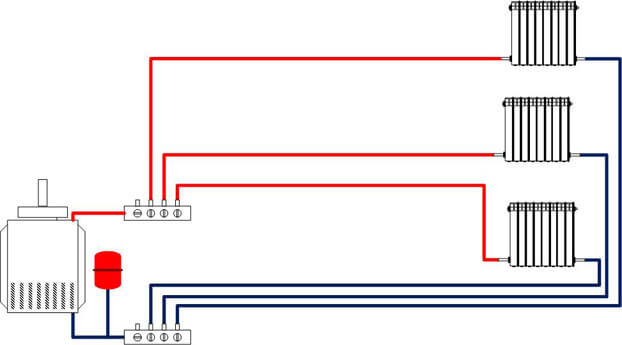

Pipes: Material Requirements
structure of a cross-linked polyethylene pipe for heating
What pipes are recommended to be selected when installing a radiant heating system with your own hands? There are several criteria that determine the operational and technical qualities of the future highway. The starting point can be considered the installation conditions - the pipes are mounted in a cement screed or under a decorative wooden floor.
The specificity of laying such a line lies in the need to bend pipes, the angles of which are most often not equal to the standard ones. Therefore, it is recommended to use a material that is flexible enough to avoid a large number of joints. Cross-linked polyethylene is best suited for the radiant heating system of a private house.
The XLPE pipe structure must have an airtight layer.
This is a prerequisite, since without it, polyethylene will allow air molecules to pass through, enriching the coolant. As a result, the rusting process will progress on the inner surface of the radiators and the heat exchanger of the boiler. The material of manufacture must be indicated on the radial heating scheme.
In addition, when choosing pipes, you need to pay attention to the following factors:
- For collector wiring, it is typical to use pipes for circuits with a smaller diameter than the section of the common supply pipe. The optimal size is 32 or 24 mm;
- Providing protection against mechanical stress. The radiant heating pipes of the house, laid on the floor, are poured with a cement screed. During this, you need to ensure that the line is not squeezed.
When installing a radiant heating system of a private house, only on its own, the integrity and correctness of the pipe connection is checked before pouring the screed. To do this, after installing all the elements, the heating boiler is started. There should be no leaks during the circulation of the liquid through the lines. Only after completing such a check can the decorative floor be equipped.
Manifold cabinets and blocks
In an apartment with horizontal radial heating distribution (on the floors of private houses), distribution manifolds (supply and "return") are arranged, collecting all supply and return pipelines at their exits. They are placed in metal cabinets of special design, often built into the partitions of sanitary facilities and opening inside them. Installation of distributor collectors in specially arranged wall niches is also possible. Quite often the collector unit is combined with the heat energy metering unit in one collector cabinet.
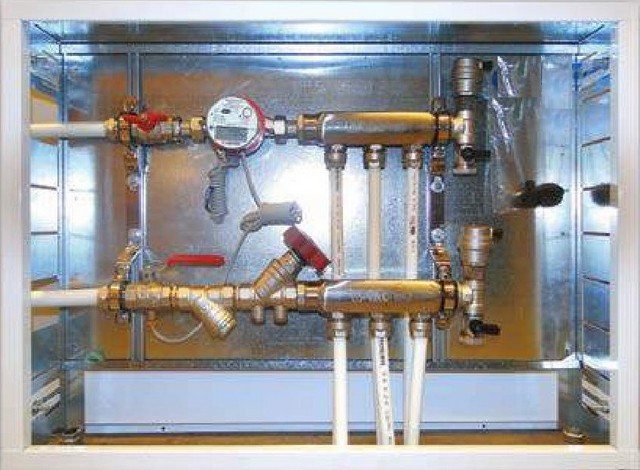

Collector cabinet with heat metering unit.
Collectors can be complete, representing sections of thick pipes with branch pipes, or assembled on tees. The material for these devices can be:
- plastic;
- nickel-plated brass;
- copper;
- stainless steel.
Many well-known manufacturers of heating equipment (VALTEC, etc.) produce ready-made manifold blocks that combine supply and return manifolds, manual adjustment valves (on the supply manifold), thermostatic valves (on the return manifold), automatic air vents, drain valves and mounting brackets.
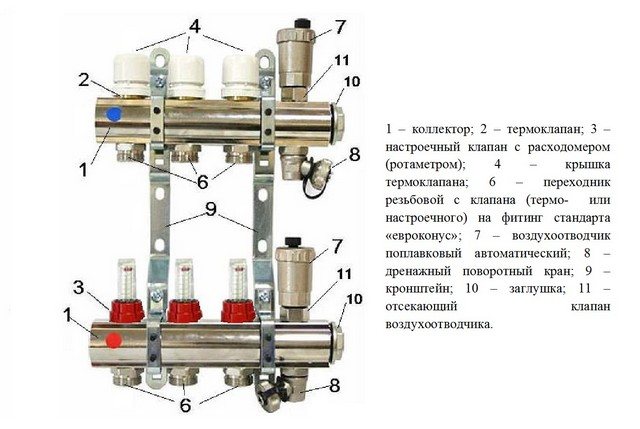

Complete manifold block.
The task of individual adjustment of the thermal regime of each single-radiator branch of the collector-beam heating system is solved by tuning valves with built-in flow meters. The branches are of different lengths, and the coolant tends to flow in the shortest path with minimum hydraulic resistance. It flows around short branches more intensively, warming up the radiators installed there more strongly.
Adjusting valves on the supply manifold change the flow of water (antifreeze), narrowing their nominal passages in short circuits, and expanding in long ones. Adjustment is a painstaking process, and the adjustment valve is not intended to quickly shut off or open the coolant flow through the circuits. This function is performed by thermostatic valves.
Thermal valves on the manifold - "return" - are valves that smoothly shut off the flow manually or automatically. The radiant heating system is easily hydraulically balanced.
Features of the radiant heating system at home
However, there is one more point that should not be overlooked. This is tuning or regulation. It is performed just in the regulation of the taps located on the manifold. But it is worth saying that such a system is inconvenient because all the time it is necessary to regulate the modes, which is not always possible to afford purely physically. In addition, if you have a rather large building, then it is better to refuse this idea.
The bonfire is the first direct descendant of radiation heating, and the Russian stove is a vivid example of this. Large, occupying a significant amount of space, it was able to heat the house with its infrared radiation, or, in a simple way, with live heat. If the room is warm, then the radiation of heat, as such, does not occur, the person feels comfortable. And if there are cold walls, ceiling and other interior items in it, to a greater extent, it is on them that infrared rays emitted by a person are transmitted. Surely, anyone can remember the chills running through the body in a seemingly warm room. This is radial heat exchange, on the principle of which the radiant heating system of a house is built.
Frequently asked questions about the ray system
What pipe diameter should you choose?
Most often, when installing a beam system, pipes of 16 diameters are enough for the eyes. In rare cases, a larger diameter is used. Now we are talking of course about the diameter of the pipes from the collector.
How to do it in a two-story house?
Many people wonder how to make a beam system in a two-story house. You can make a ray system even in a skyscraper. The main thing is to use its own heating collector on each floor.
Is it possible to make a beam system in an apartment?
Yes, you can. It is unlikely that it will be possible to do this directly from the CHP. But if you have your own heating system or connect to a CHP plant through a heat exchanger, then everything will work.
Is it better to have a two-pipe system or a beam system?
Overview of diagrams and components of the heating system
At the first stage, it is necessary to choose the principle of operation of the heating system. Even 20-25 years ago, there was practically no alternative - they made a gravitational open system. Therefore, the question of how to properly mount the heating was reduced to the choice of the diameter of the steel pipes and their correct slope.But the appearance on the market of the main elements of a closed system has significantly expanded the choice of a circuit.
Gravity heating system
Gravitational heating scheme
The main source of heating water for it is a solid fuel boiler (operation on a diesel engine or waste oil is possible). Installation of gas models is not possible, since their normal operation implies increased pressure in the pipes. Self-assembly of a heating system with a gas boiler is possible. But in this case, a solid fuel body is used, in which a special gas burner is mounted.
Before properly installing heating in a private house, you need to select its main components. In addition to the boiler, the following elements are mandatory:
- Pipes. For this type of heating, you can use plastic models (polypropylene, metal-plastic) or steel. It is best to choose a large diameter - from 40 mm. In this way, the total hydraulic resistance can be reduced;
- Expansion tank. It is necessary to stabilize the system in case of overheating of the coolant;
- Shut-off valves. Its installation is mandatory, since during repair or maintenance work it will be necessary to shut off the coolant flow in a certain section of the system;
- Make-up unit. Required to add coolant. In order to optimize it, it is often included in the design of the expansion tank.
Radiator complete set for one-pipe heating system
The gravitational system in most cases is made one-pipe (Leningrad). In order to properly mount the heating radiator, it is necessary to install a bypass on each of them. This also needs to be taken into account when purchasing components and drawing up a general installation scheme.
In addition to these components, installation of pressure gauges is required. If this device is not provided in the boiler design, it should be installed on the outlet pipe.
To mount a heating radiator, it is imperative to provide for the presence of a Mayevsky crane in it. It is necessary to eliminate air congestion in the system.
Forced circulation heating system diagram
Closed heating circuit with a solid fuel boiler
It is much more difficult to install a forced circulation heating system. The difference lies in the creation of increased pressure in the line. This contributes to an increase in the length of pipelines and an optimal temperature regime for the operation of the entire system.
The complete set of this scheme is best considered using the example of a solid fuel boiler piping. Since in most gas models, the overwhelming majority of the components are part of the structure (circulation pump, expansion tank, etc.). Therefore, in order to mount the heating system yourself, in addition to the boiler, the system must necessarily contain:
- Circulation pump. It will create the required level of coolant pressure;
- Closed expansion tank. Serves as a compensator when the pressure in the system rises above the critical one;
- Security group. Partially duplicates the functions of the expansion tank. If the pressure readings are too high, then the air vent and drain valve will reduce it, removing excess air and coolant from the system;
- Shut-off valves;
- Make-up unit.
How to mount a closed-type heating system yourself, and most importantly - which pipe layout to choose? Experts recommend installing a two-pipe one, since the radiators in this case will be connected in parallel, which will ensure an even temperature distribution throughout the system.
It is much easier to install a forced-type heating system than with natural circulation. In addition, the first is the only option for houses with a medium to large area.
Advantages of a beam (collector) piping layout
If we compare the radiant heating system with more classical (one- and two-pipe), then it has just a lot of advantages.
Among the most significant advantages are:
- Possibility of hidden laying of pipes and all constituent elements of object heating;
- Lack of connections (and therefore weak points) between the heating devices and the comb;
- Ease of installation of all elements, do-it-yourself work, even without certain skills. The minimum number of connections is used, and therefore the assembly of all components is extremely fast;
Circulation pump for collector heating circuit
- System stability. When using a beam wiring, there is no possibility of water hammer. It is especially important when using expensive imported sanitary ware with a boundary pressure of 3 atm;
- Fast and effective replacement of damaged sections of the pipeline without complex installation work, destruction of the concrete screed structure. It is enough just to turn off any of the beams of the circuit and defects can be easily eliminated without disrupting the operating mode of the entire system;
- Affordable price of equipment and all components;
- Simplification of the design and installation of the heating system through the use of pipes of the same size, divorced from the "comb".
Collector selection
The radiant heating system includes a collector (comb). This element looks like a pipe. It has nozzles for the inlet and outlet of the coolant. For the beam scheme, two types of collectors should be installed.
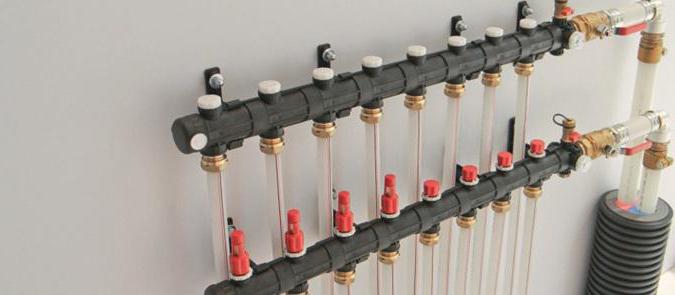

The first of these will be the inlet comb. A pump is connected to it, as well as a coolant distribution valve. It can be three- or two-way. The valve includes a thermometer. It is installed in the collector housing. The device transmits information to the valve. It opens or closes the damper, mixing hot liquid into the circuit.
The outlet collector collects the cooled heat carrier, which is returned to the boiler. The heater heats it up again. Additionally, a balancing flow controller can be installed on this branch pipe. The collector group ensures the stability of the system. She is responsible for optimizing and balancing the heating of the coolant in the system.
Single pipe horizontal
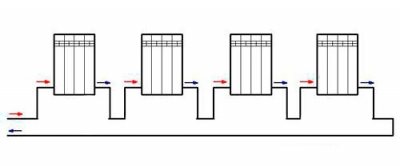

The simplest version of a one-pipe horizontal heating system with bottom connection.
When creating a heating system for a private house with your own hands, a single-pipe wiring scheme may be the most profitable and cheapest. It is equally well suited for both one-story houses and two-story houses. In the case of a one-story house, it looks very simple - the radiators are connected in series - in order to ensure a consistent flow of the coolant. After the last radiator, the coolant is sent through a one-piece return pipe to the boiler.
Advantages and disadvantages of the scheme
To begin with, we will consider the main advantages of the circuit:
- ease of implementation;
- great option for small houses;
- saving materials.
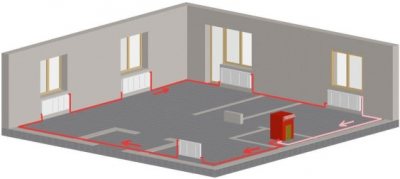

A single-pipe horizontal heating scheme is an excellent option for small rooms with a minimum number of rooms.
The scheme is really very simple and straightforward, so even a beginner can cope with its implementation. It provides for a serial connection of all installed radiators. This is an ideal heating wiring diagram for a small private house. For example, if it is a one-room or two-room house, then it does not make much sense to "fence" a more complex two-pipe system.
Looking at the photo of such a circuit, we can note that the return pipe is one-piece here, it does not go through the radiators. Therefore, such a scheme is more economical in terms of material consumption.If you do not have extra money, such a layout will be the most optimal for you - it will save money and allow you to provide the house with heat.
As for the shortcomings, there are few of them. The main disadvantage is that the last battery in the house will be colder than the very first one. This is due to the sequential passage of the coolant through the batteries, where it gives off the accumulated heat to the atmosphere. Another disadvantage of a one-pipe horizontal circuit is that if one battery fails, the entire system will have to be turned off at once.
Despite certain disadvantages, such a heating scheme continues to be used in many small private houses.
Features of installation of a one-pipe horizontal system
Creating water heating for a private house with your own hands, a single-pipe horizontal wiring scheme will be the easiest to implement. During the installation process, it is necessary to mount the heating batteries, and then connect them with pipe sections. After connecting the very last radiator, it is necessary to turn the system in the opposite direction - it is desirable that the outlet pipe runs along the opposite wall.
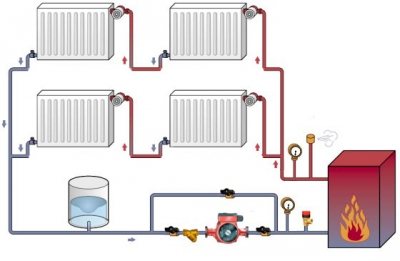

A single-pipe horizontal heating scheme can also be used in two-story houses, each floor is connected in parallel here.
The larger your home, the more windows it has and the more radiators it has. Accordingly, heat losses also increase, as a result of which it becomes noticeably cooler in the last rooms. You can compensate for the drop in temperature by increasing the number of sections on the last radiators. But it is best to mount a system with bypasses or with forced circulation of the coolant - we will talk about this a little later.
A similar heating scheme can be used to heat two-story houses. For this, two chains of radiators are created (on the first and second floors), which are connected in parallel to each other. There is only one return pipe in this battery connection diagram, it starts from the last radiator on the first floor. A return pipe descending from the second floor is also connected there.
Diy radiation heating
An example of a radiant heating circuit
Is it possible to make a professional drawing of a radial heating system for a two-story house? This is quite possible if you apply an integrated approach to solving this problem. This will require initial design skills (creating elementary drawings), knowledge of the basics of heating. If you are not confident in your own abilities, it is recommended to contact specialized design companies.
For those who want to make a radiation heating system for a private house with their own hands, the work should be divided into several stages:
- Mayevsky crane (air vent)
Room condition analysis... The main condition for laying pipes is the absence of a finished floor. It can be equipped only after laying the highways.
- Radiator installation locations... Their installation is recommended on external walls under window structures, since there are the greatest heat losses.
- Drawing up a house plan... It first notes the initial data required for a two-tube radiant heating system - the location of the boiler and radiators.
- The plan indicates the laying of pipelines... For a two-story house, it is first planned to install a central distribution manifold, to which separate circuits will be connected.
- Shut-off and safety equipment... The radiant heating circuit must have safety groups and shut-off valves. These include Mayevsky taps (air vents), manometers, thermometers, overlap and manifold taps. Their installation order is necessarily indicated on the diagram.
The last point is very important, since for standard piping, it is enough to install one air vent.In our case, their number should be equal to the number of circuits in the system. This is necessary in order for the radiation heating system of a private house to work normally, without the occurrence of air jams. The Mayevsky crane is installed at the highest point of the contour. This is usually the upper radiator pipe.
Radiant heating system for two-story house is the best choice
At the moment, it is simply not possible to find a more efficient and economical floor heating system for two-story private country houses than a two-pipe beam scheme. Having correctly selected the equipment, as well as having calculated all the nuances and completing the installation, as required by the instructions, you can ensure comfort and coziness in the house.
It is important to point out the fact that traditional radiators are the main heating devices in a radial double-circuit system. Regardless of the size and material (and it can be both cast iron and aluminum), such units must be installed correctly:
Regardless of the size and material (and it can be both cast iron and aluminum), such units must be installed correctly:
- Heating batteries must be installed only under window openings;
- All radiators must be installed at the same height;
- The ribs of the battery are located only vertically - otherwise, normal circulation of the coolant will be impossible;
- It is imperative to provide a drain system through which the coolant will be replaced.
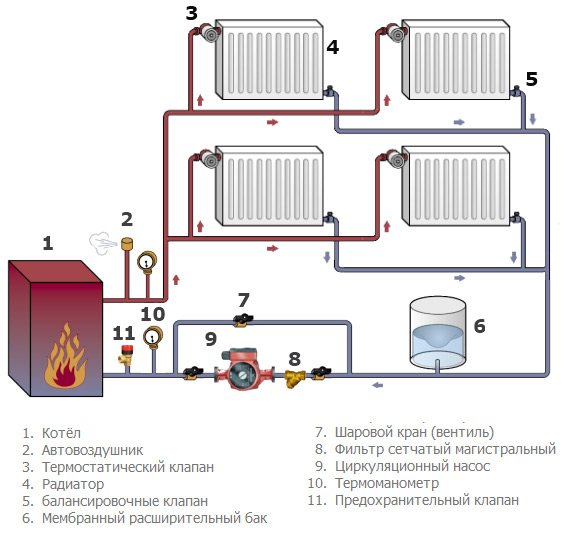

Two-pipe heating system for a house with two floors
A boiler also means a lot (see how to choose a gas heating boiler)
For the normal operation of a two-circuit system, it is important to choose modern and efficient boilers. Such a technique (and even equipped with automation) will make it possible to ensure optimal heating of each room of a two-story house, significantly saving fuel and finances and getting hot water
The heating system of a two-story building of a two-pipe radiant heating circuit is not only quite efficient and effective, but also demanding for the first start-up.
So, for example, before starting direct operation, it is important to correctly balance the system, adjust the fluid flow for each loop of the supply and return pipelines. This is the only way to achieve fuel economy, ensure the highest possible heating level
Modern heating systems
Quite a lot of time has passed since the time of the Russian stove, and although it is an ideal option for radiant heating at home. but at the present time, installing it in a city apartment is nonsense. But technologies are also developing every day, so all heating systems, including radiant ones, installed both in private houses and in apartments, are mostly the most modern, and are adapted to the needs of each person.
Heating systems, first of all, are divided according to how the pipes are fed from the collector to the radiators. These are several types of systems, such as;
- One-pipe;
- Two-pipe;
- Beam;
The principle of radiant heating is that the wiring from the collector, the main distributor of the coolant, is meant for each radiator separately. This is the most significant plus in this system - radiators can be turned on and off, either individually or as a group.
In addition, the heat supply valve can be adjusted. For example, if the kitchen does not require such an amount of heat radiation, due to the work of household appliances that serve as an additional source of heat, then the valve can be screwed on. This can be done so that heat flows into the kitchen, but not in the same amount as in other rooms. The same can be done with those rooms that are not used for their intended purpose, but they should be kept warm. By regulating the supply of heat, fuel economy is also increased.and due to this, the readings of the heat meter are also pleasing.
How is a multi-storey building heated?
- The principle of operation of the elevator unit
- About the heating system of a multi-storey building
The heating system of a multi-storey building is of particular interest, it can be considered on the example of a standard five-story building. It is necessary to find out how heating and hot water supply functions in such a house.
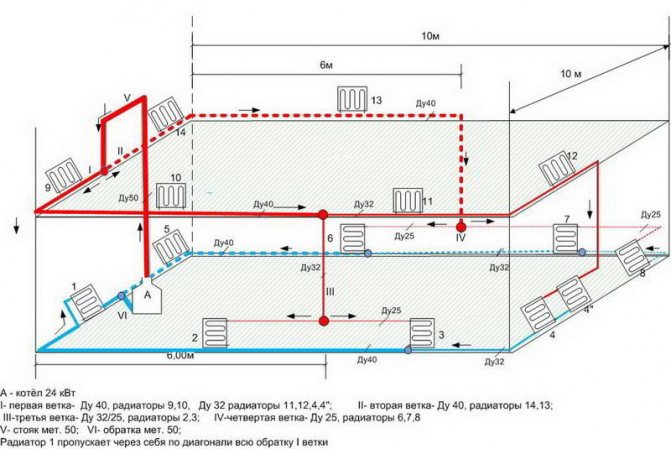

Heating scheme for a two-story house.
The five-storey building has central heating. the house has a heating main, there are water valves, there may be several heating units.
In most homes, the heating unit is locked in order to achieve security. Despite the fact that all this may seem very complicated, the heating system can be described in simple terms. The easiest way is to take a five-story building as an example.
The heating scheme of the house is as follows. After the water valves, there are mud traps (there can be one mud trap). If the heating system is open, then after the mud collectors, valves are located through the tie-ins, which stand from processing and supply. The heating system is made in such a way that water, depending on the circumstances, cannot be taken from the back of the house or from the supply. The thing is that the central heating system of an apartment building operates on water that is overheated, water is supplied from a boiler room or from a thermal power plant, its pressure is from 6 to 10 Kgf, and the water temperature reaches 1500 ° C. Water is in a liquid state even in very cold weather due to the increased pressure, so it does not boil in the pipeline with the formation of steam.
When the temperature is so high, the hot water supply is switched on from the back of the building, where the water temperature does not exceed 700 ° C. If the temperature of the coolant is low (this happens in spring and autumn), then such a temperature cannot be sufficient for the normal functioning of the DHW, then the water for the DHW comes from the supply to the building.
Now you can disassemble the open heating system of such a house (this is called an open water intake), this scheme is one of the most common.
Types of radiant heating system
A visual diagram of a heating system in a private house.
A radiant heating system in a private house can be installed with both forced and natural circulation of the heat carrier. Currently, the natural circulation system is used very rarely, since it is necessary to use pipes with a very large diameter, which is not very convenient for a private house. In addition, this system is equipped with an expansion tank, the installation of which is necessary at the highest point of a two-story house, which, again, is not entirely convenient. But at the same time, a radiant heating system with natural circulation will help save on installation, since it does not require additional expensive equipment (pumps, temperature sensors, air vents, etc.).
The collector heating system with forced circulation is the most widely used; its main advantage is the artificial circulation of heat through pipes. For these purposes, a special pump is installed in the supply or return line. Forced circulation makes it possible to reduce the temperature difference between the water inlet and outlet, and also simplifies the heating system itself, which makes it more compact and helps to avoid unnecessary waste of materials. This heating system does not depend at all on the project of the house and the location of the heated rooms in it. The hydraulic resistance of the pipeline and the length of the branches do not play a special role. And due to the installation of modern automatic devices, you can change the temperature depending on the weather conditions and the individual wishes of the residents.All these advantages make this system universal.
Selection of pipes for the heating system
The most common for the installation of heating systems in two-story houses are metal-plastic pipes. This is primarily due to the fact that no sludge is deposited on products made of polymeric materials and they are resistant to corrosion. Quite low price is another advantage of metal-plastic pipes. All connections are made without the use of welding using threaded or press connections, which maximally simplifies installation. Nevertheless, such pipes have one drawback - a high coefficient of thermal expansion, which, if used improperly, can lead to leaks.
Pros and cons of a radiant heating system
The disadvantages of radial heating in the house include:
- a large number of materials and, as a result, a higher cost;
- the need for a special place for the manifold block.
The advantages of the beam system are:
ease of installation due to the small number of connecting elements; hidden pipe laying in the floor; hydraulic stability, which is especially important when using imported sanitary ware; the ability to turn off each radiator separately, while all the others work as usual; temperature control in each individual room; balanced system, all rooms are heated evenly.
When developing a project for a radiant heating system, it is necessary to detail it as much as possible, this will greatly simplify the installation and help to avoid problems in the future. It should also be noted that the actual costs will always exceed the planned ones, this must be taken into account when drawing up the estimate. But, in spite of everything, the radiant heating system is highly efficient and capable of creating maximum comfort in the living space.
Collector system accessories
The set of elements of the radiant heating system is similar to the set of a conventional tee system. In both of these systems, the heating boiler is the main element. In order for the beam system to be effective, you need to be very careful about the selection of the power of the heating boiler. When choosing a boiler, you need to build on the area of the heated room, but it is important, plus everything, to take into account heat loss.
The wiring of the radiant heating system also includes a pump that circulates the coolant. The radiant heating system does not work by gravity. Therefore, the overwhelming majority of radiant heating systems have a circulation pump in their scheme. The pump must also be in the correct location. Let's move on to the second very important element of the radiant heating system - the collector.
This element is nothing more than a switchgear. With the help of the collector, the coolant is supplied to all segments of the heating system. The Collector includes numerous elements of shut-off equipment, which allow differentiated regulation of the temperature of the living space, up to individual radiators in the rooms. As a rule, the collector is mounted in a separate panel or in a cabinet that fits perfectly into the interior and does not irritate the eyes. Now let's talk about circulation separately.
Varieties of beam wiring
Method 1.With forced water circulation
Previously, a radial heating system equipped with pumps that pump water was not very popular due to the high cost of parts. But now the price of equipment has dropped significantly, and more and more people are choosing it.
The main difference from the gravitational scheme is that liquid (water or antifreeze) flows from the boiler to the batteries and back not due to the difference in temperature and pressure, but with the help of pumps.
This achieves the following advantages:
- there is no limit on geometry and number of rooms in housing construction;
- heating can be installed in any area of the premises;
- to connect radiators and collectors, you can use pipes of any length, laid without a slope.
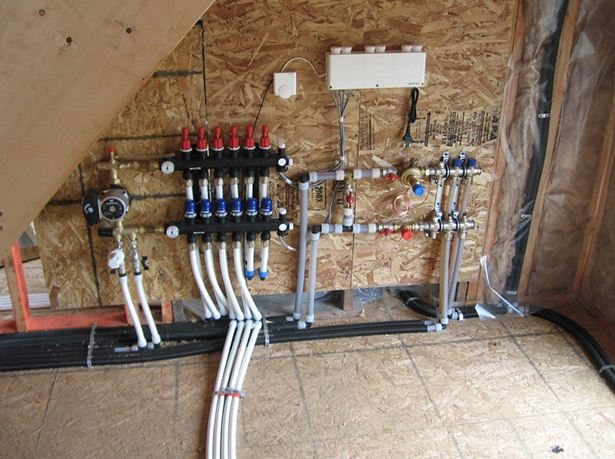

One of the elements of a radial heating system with forced circulation is a pump
Advice! Despite the fact that the circulation pump can be installed at any point in the system, it is advisable to do this on the return manifold before supplying the coolant to the boiler. There, the temperature of the liquid is the lowest, which has a positive effect on the service life of the equipment.
Method 2.With natural water circulation
In this case, the coolant moves due to gravity: the heated water becomes less dense and lighter, therefore it is displaced to the upper point of the system, after which, as it cools, it flows through the collectors and radiators, and then returns to the heater.
The gravitational beam heating system has the following features:
- Installation requires an open expansion vessel at the highest point. It compensates for the thermal expansion of the coolant and prevents an increase in internal pressure in the pipelines.
- The natural circulation radiant heating network does not require the installation of expensive electrical equipment, which significantly reduces the estimated cost of the work.
- Natural circulation heating is completely non-volatile. Even with a power outage, which often happens in summer cottages or in rural areas, you will not be left without heat.
The gravity heating system does not use pumps
Beam layout features and elements
The most optimal heating system using radiation is suitable, especially for apartment buildings, or private houses with more than one floor and many rooms. This significantly increases the efficiency of the entire equipment as a whole, guarantees high-quality heat supply and significantly reduces the amount of heat and energy indicators.
The principle of operation of a radiant heating system is quite simple, but it has some peculiarities. For example, if the building has several floors, then the installation of a collector is assumed on each floor. Moreover, in many cases, not one, but several collectors are installed, and pipes are already laid from them, and the organization of direct and reverse supply of the coolant. It is also worth noting the fact that radiant heating of a house works effectively only if the house is well insulated. due to which the least heat loss occurs. If the house is insulated from the inside. and outside - there will be no problems with heating based on the principle of infrared radiation. If, on the contrary, all the heat will go to heating walls, window panels, floors, and so on.
But by itself, a radiant heating system is a complex design. combining basic and additional elements necessary for high-quality work. This can include;
- Boiler. which is almost the main element. It is from it that heat is supplied to the pipes, and through the pipes to the radiators.
- Circular pump. which creates a certain pressure in the pipes, with the help of which the heat carrier circulates, and the optimum comfortable temperature in the premises is maintained. It also guarantees the efficient operation of the entire heating system;
- The collector (or in another way - the comb) is another most important element in the radial heating system. It is, as it were, the center, and it is from it that the uniform supply and distribution of heat to all rooms of the house comes;
- Cupboard. where all heating elements must be hidden. The manifold cabinet hides the distribution manifold itself. pipes and valves. It is a fairly simple design, but very functional and practical. They can be located both outside and built into the wall;
Installation features
All such systems are mounted and designed for a specific house, taking into account the dimensions, area, number of rooms and floors, the planned coolant, radiator and some other parameters.
However, there are a number of rules that must be followed during installation. The use of the beam system in an apartment building is not permitted. Since the coolant circulates along vertical risers that unite all rooms into a single network. Due to the connection of several collectors to the system, the liquid will not circulate to the upper floors.


Installation process
In private houses, you can equip a ray system if you follow these recommendations:
- All collectors that circulate the coolant for radiators must necessarily be fitted with valves that would prevent the formation of plugs.
- The circuit must be equipped with an expansion tank with a volume of 10% of the total amount of liquid circulating through the pipes. The best option is to use a membrane tank.
- The tank is attached to the pipeline, which connects the outlet tank with the heating element.
- If you plan to attach multiple pumps, make sure they are horizontal. Otherwise, they will break, requiring costly repairs or replacement.
Preparing for installation
Before all work, it is required to draw up a project. It is especially important to refer to the formation of the drawing. It should be detailed enough, with all calculations and dimensions. If it is impossible to do it yourself, you can attract specialists.
Also required:
- Select locations for batteries.
- Select the type of radiators and the number of sections.
- Make a list of required materials and equipment.
Installation of a radiant heating system
Collector-beam heating systems are mounted under the floor. In this case, it is required to follow several recommendations.
A rough floor or base can be the foundation of a building, on which a heat insulator is attached, after which a pipeline is placed. After that, the pipeline from the previously purchased and cut segments is connected. So that when pouring concrete it does not rise, it is advisable to attach it in any of the ways.
After that, around the network, it is required to place a foam insulation up to 5 centimeters and nail it in with dowels. After that, it can be poured with concrete, up to 50-70mm.
What is the difference between tee wiring and radial
Such installation is quite complex, which increases the risk of breakdowns in the event of installation errors or sudden pressure drops in the heating system.
Beam layout
Radiant heating system involves laying pipes from each radiator to a special distribution device - a collector or, as it is also called, a comb. Naturally, the flow rate of pipes increases significantly here. In addition to pipes, each radiator will need its own shut-off valves - valves, thermostats, tees and other small parts, and some of them must be installed on both pipes - supply and return.
But, despite the high consumption of components, such a system makes it possible, in the event of an emergency, to quickly turn off any radiator, group, separate room or whole floor. The heating system can continue to operate during this time and heat the premises.
In addition, with radial routing, pipes are usually hidden under the floor covering, regardless of its material.
This gives an additional chance to make the floor warm, which is so important in houses where the basement is not insulated. One-piece pipe, without joints, made of cross-linked polyethylene and laid under the floor, eliminates the risk of leaks, and all repairs, if required, are carried out directly at the radiator connections or in the manifold
Is it worth doing a manifold heating wiring
Let's start with the disadvantages.They must be taken into account when deciding on the choice of the type of distribution of heating pipes. The collector system is considered expensive due to the consumption of materials. In addition, you need to find a place to equip cabinets, which is sometimes difficult. If the costs and the need to allocate space for the collectors are not scary, then the homeowner receives the following benefits:
- Stable operation of the heating system. The equipment is not exposed to water hammer, which increases the life of the radiators.
- Simplified design. The system uses pipes of the same diameter, which eliminates unnecessary calculations.
- Convenient renovation. If damage appears in any area, this circuit is simply turned off and the problems are rectified. The rest of the "rays" work in the same mode, the house maintains an acceptable temperature.
- Concealed installation. The pipes are placed in the floors, walls or ceilings, and the comb and the automation in the manifold cabinet. Heating elements do not spoil the interior.
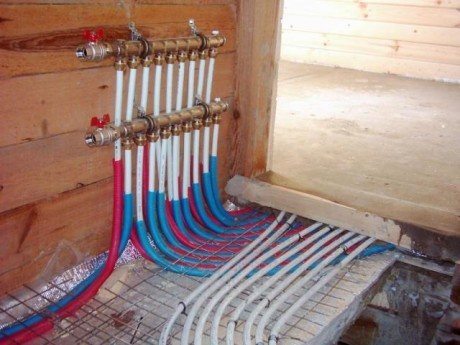

It looks like a collector piping
Whether to opt for a beam wiring or prefer the good old tee is up to you. Weigh the advantages and disadvantages, calculate the costs of installing different types of systems and start designing. Warmth to your home!

